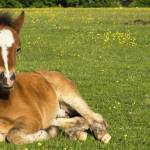Foals Born Early in the Year Are Smaller

Breeders know that season, especially in the Northern Hemisphere, greatly impacts a mare’s reproductive cycle. Under natural conditions, mares may cycle in April and foal in March but typically the breeding season begins later. Breeders seeking to produce foals earlier in the year—a common practice in sectors of the industry with January 1 as a universal birthday—use artificial lighting in the winter months to advance the breeding season. One recent study*, however, found that doing so may actually be counterproductive because early breeding produces smaller foals.
In the study, European researchers measured foals born in January, February, and March. Those measures included withers height, body weight, crown-rump length, carpus-elbow length, and others. After analysis, the research team concluded “fetal size is reduced when the final growth phase coincides with the winter months.”
The researchers’ hypothesis was that both a mare’s estrous cycle and a foal’s gestational growth change with photoperiod. In wild horses, like Przewalski’s horses, metabolic activity decreases in winter. If this decreased metabolism also occurs in domesticated horses, which appears likely, then mares carrying foals during the winter months also have decreased metabolism during a critical phase of foal growth. As a result, foals born in January are smaller than those born in March.
According to Beythien and colleagues, the smaller stature persisted for the first three months of life. Whether or not early born foals are smaller for life remains to be determined, but certainly raises some interesting questions regarding the rationality behind the January 1 birthdate. This data coincides with earlier research conducted by Kentucky Equine Research (KER).
“Regardless of the style of breeding operation or which hemisphere the horse resides in, achieving optimal reproductive health in both mares and stallions can be facilitated by supplementing with omega-3 fatty acids,” said Kathleen Crandell, Ph.D., a nutritionist with KER.
KER offers EO•3, an excellent source of long-chain omega-3 fatty acids. This palatable liquid supplement contains the marine-derived long-chain fatty acids DHA and EPA.
*Beythien, E., C. Aurich, M. Wulf, et al. 2017. Effects of season on placental, foetal and neonatal development in horses. Theriogenology. 97:98-103.








